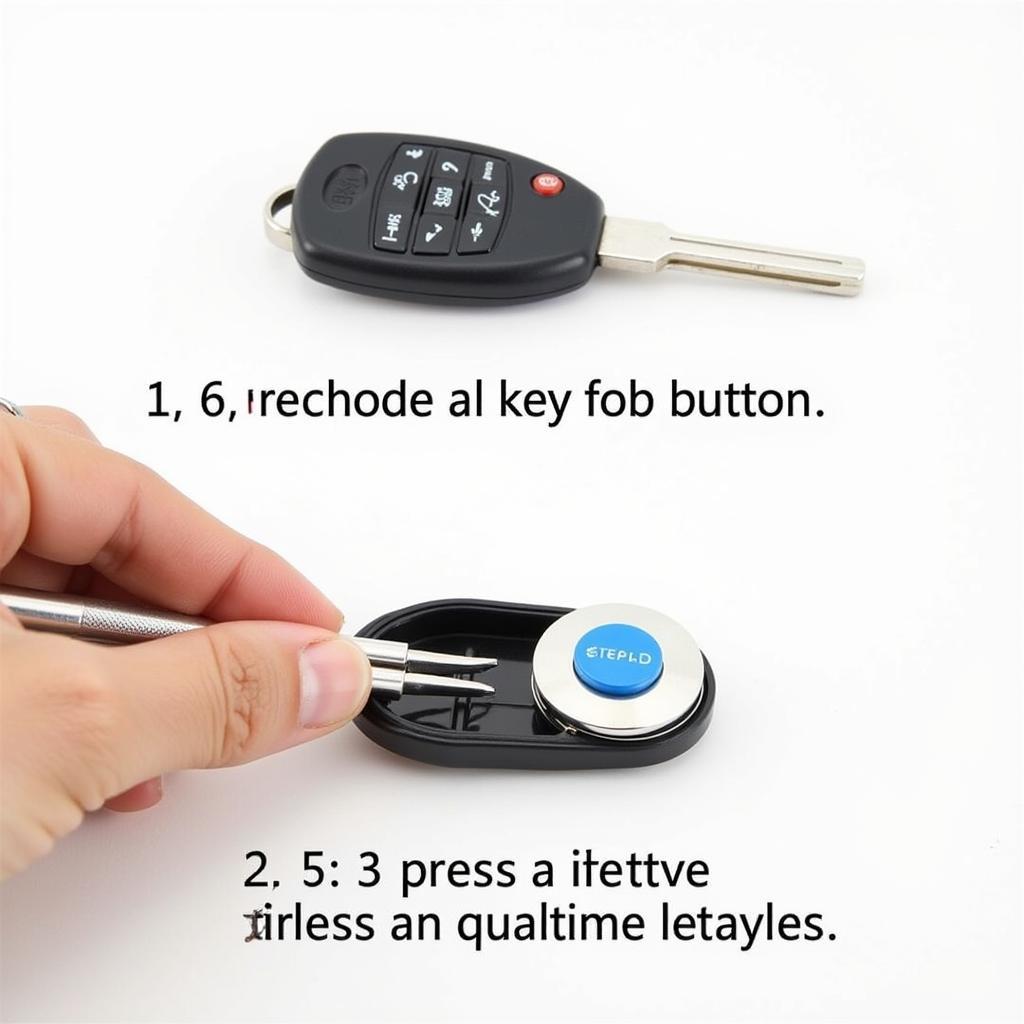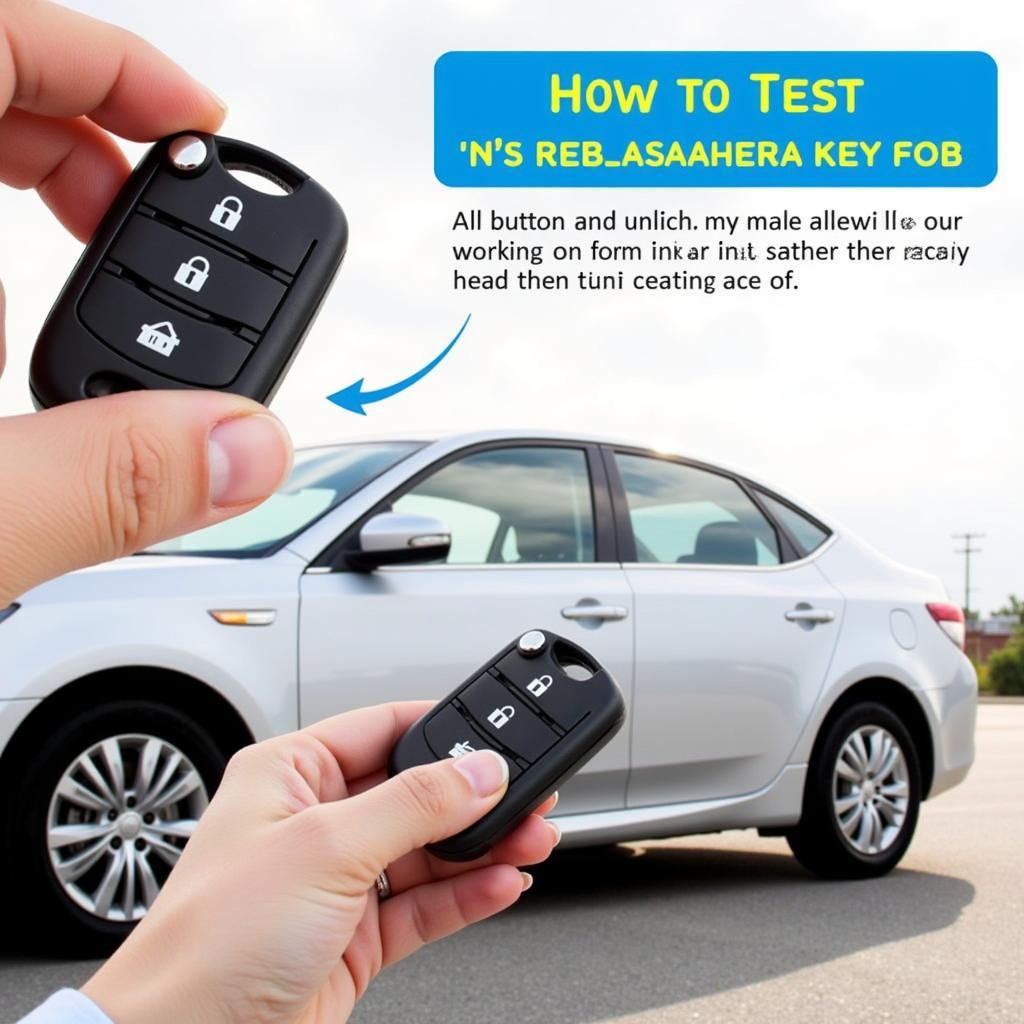Reattaching a broken key fob can feel like a daunting task. Whether it’s a loose button, a separated key blade, or a cracked casing, knowing How To Reattach Parts In A Key Fob can save you time and money. This guide will provide a comprehensive walkthrough on how to tackle common key fob repairs, from simple fixes to more complex reattachments.
 Reattaching a Key Fob Button
Reattaching a Key Fob Button
Common Key Fob Part Separations and Their Fixes
Key fobs, despite their compact design, contain several small parts that can become dislodged. Identifying the separated part is the first step to a successful repair.
Loose Buttons
Loose buttons are a common issue. They can become detached due to wear and tear or accidental drops. If the button is still intact, reattaching it can be a simple process. Often, applying gentle pressure can snap the button back into place. For more stubborn buttons, a small flathead screwdriver can help to carefully pry the button back into its housing. how to repair a broken key fob ring can be a useful resource for related issues.
Separated Key Blade
A separated key blade can render your key fob useless. The method for reattachment depends on the key fob’s design. Some key fobs have a small screw that secures the key blade. Tightening or replacing this screw can solve the issue. Others require you to carefully slide the key blade back into a track or slot.
 Reattaching a Key Fob Blade
Reattaching a Key Fob Blade
Cracked Casing
A cracked casing not only looks unsightly but can also expose the internal components of your key fob to damage. While some minor cracks can be repaired with strong adhesive, a severely damaged casing might require replacement. You can find information on replacing key fob parts online or consult a professional locksmith. can the key be changed on a 2012 ford fob offers specific guidance on key fob replacement.
Step-by-Step Guide to Reattaching Key Fob Parts
Before attempting any repairs, gather the necessary tools, including a small flathead screwdriver, tweezers, and a magnifying glass.
- Identify the Problem: Carefully examine your key fob to determine the exact part that needs reattaching.
- Gather Your Tools: Having the right tools can make the repair process much smoother.
- Consult Your Key Fob Manual: Your key fob manual may provide specific instructions for reattaching parts.
- Reattach the Part: Use the appropriate tools and techniques for the specific part you’re reattaching. Apply gentle pressure to avoid further damage.
- Test the Key Fob: Once the part is reattached, test all the functions of your key fob to ensure it’s working correctly.
 Testing a Reattached Key Fob
Testing a Reattached Key Fob
Expert Insights on Key Fob Repairs
“Many key fob issues can be resolved with some simple DIY fixes,” says John Smith, a certified automotive locksmith with over 20 years of experience. “However, if you’re unsure about how to proceed, it’s always best to consult a professional.”
“Regular maintenance can prevent many key fob problems,” adds Emily Johnson, an automotive electronics specialist. “Keeping your key fob clean and dry can significantly extend its lifespan.” how to change key fob battery ford explorer provides useful information on key fob maintenance.
Conclusion
Learning how to reattach parts in a key fob can be a valuable skill. By following these steps and exercising caution, you can often fix minor key fob issues yourself. Remember, if you’re ever unsure about a repair, seeking professional help is always the safest option.
FAQ
- What type of glue should I use for a cracked key fob casing?
- Can I reattach a broken key fob button myself?
- Where can I find replacement parts for my key fob?
- How do I know if my key fob needs professional repair?
- What are common causes of key fob damage?
- How can I prevent my key fob from breaking?
- Are there any specialized tools for Key Fob repair?
Need further assistance? Contact us via WhatsApp: +1(641)206-8880, Email: [email protected] or visit us at 123 Maple Street, New York, USA 10001. We have a 24/7 customer support team.

Leave a Reply